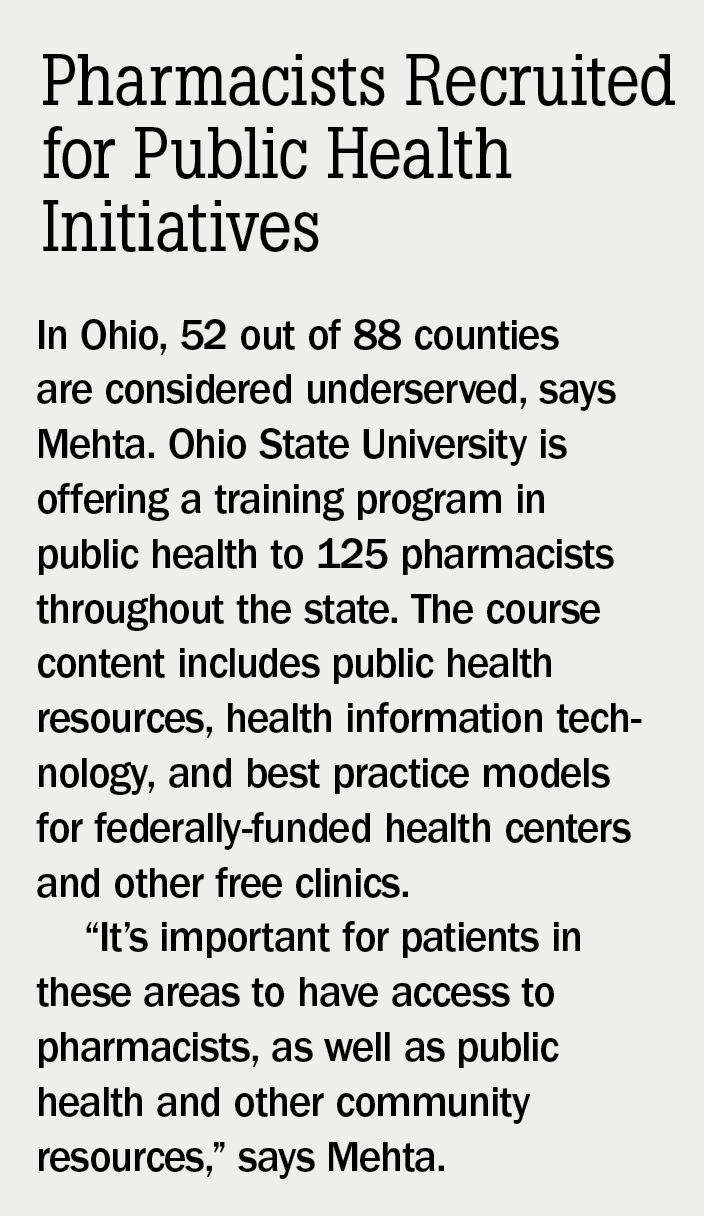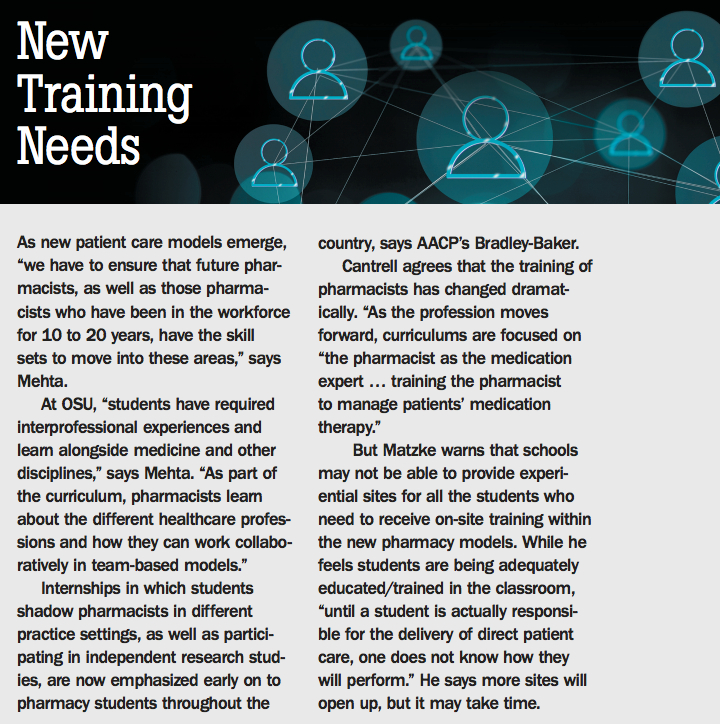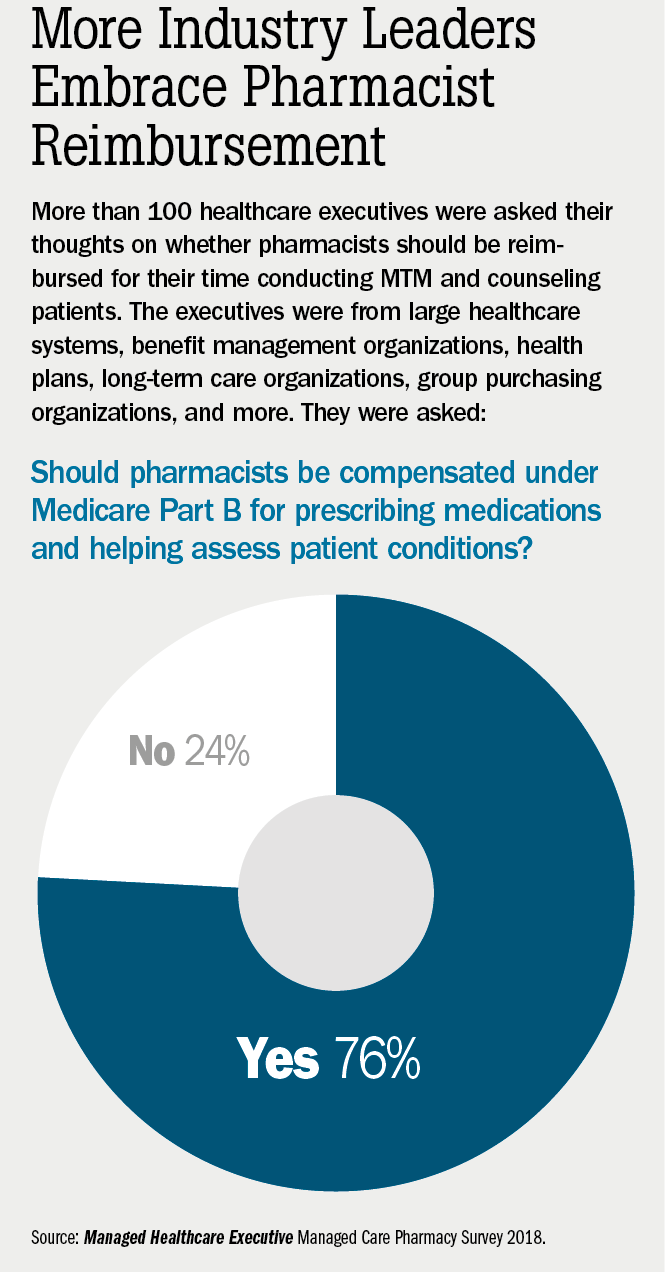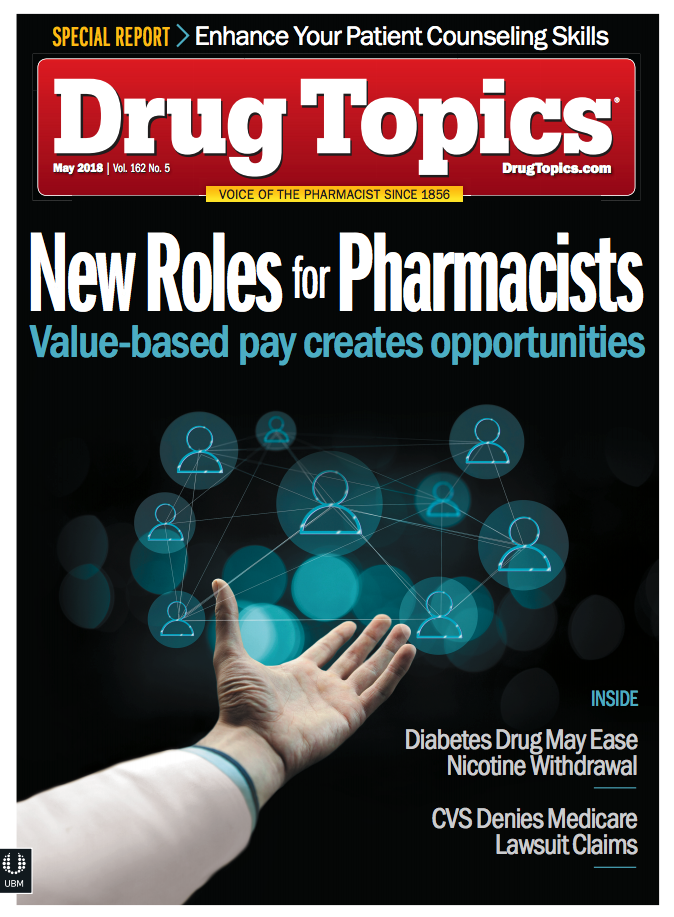Top Ways Pharmacists’ Roles Are Changing
Physicians are looking to pharmacists to help satisfy value-based metrics. Here’s how it’s changing pharmacists’ roles.

Click to expand

The pharmacist’s role is expanding as the healthcare arena moves from fee-for-service to value-based payments.
“Physicians are warming to the idea of working alongside pharmacists in their practice settings. In fact, not only are they warming to it, many physicians are carving out a pharmaceutical piece of part of their risk-sharing agreements,” says Susan Cantrell, RPh, CEO of the Academy of Managed Care Pharmacy (AMCP).
Medicare accountable care organizations (ACOS) do not directly include pharmacists and medications, but appropriate medication management is necessary to ensure success of value-based arrangement, Cantrell explains. “Therefore, we are seeing a trend where physicians are trying to integrate pharmacists and medication management to achieve good outcomes,” she says.
Related article: How to Manage Medication Risks
Medication therapy management (MTM) is one of the biggest areas in which physicians increasingly rely on pharmacists, says Lucinda Maine, PhD, RPh, executive vice president and CEO of the American Association of Colleges of Pharmacy (AACP). “As physicians need to meet expectations around quality-based metrics, they are finding they can move those quality needles when a pharmacist provides MTM.”
In some cases, pharmacists embedded in practices or hospital pharmacists are meeting with patients prior to physician visits and conducting thorough medication reviews and assessments. “This relieves the physician of doing that part of the care plan,” she says. “Once physicians sees the value of the pharmacist, they don’t want to practice any other way.”
Community pharmacists are also experiencing role changes, as they too are providing medication management across the continuum of care. Some community pharmacists are partnering with nearby hospitals to more thoroughly counsel patients regarding medication and adherence. The expanding role of pharmacy technicians and robotics should also liberate these pharmacists to take on more of these tasks, says Maine.
Here's more on how the role of pharmacists is changing in various practice settings.
Community Pharmacy
Community pharmacy is the biggest area in which pharmacists can be better used because they have such frequent interactions with patients, says Marilyn Stebbins, PharmD, vice chair for clinical innovation, University of Southern California San Francisco (UCSF) School of Pharmacy. “Most people visit a retail pharmacy more than 20 times a year; this is where the pharmacist’s impact is the greatest,” she says.
Pharmacists are offering vaccinations, blood pressure screenings, and counseling on specific disease states such as diabetes. “In the retail setting, MTM, and not dispensing, should be the priority,” says Stebbins. “In this way, pharmacists can help improve outcomes and show their value.”
Related article: How Pharmacists Can Team Up with Physicians to Improve Care
Community pharmacists are also experiencing a growing role as hospitals look to them as a resource to improve adherence and reduce readmissions, a key metric in many value-based payment arrangements. One example is the “Meds to Beds” program at UCSF. Pharmacists from two retail pharmacies on the hospital campus meet with patients before they leave the hospital. The pharmacists explain their discharge medications and then follow up with patients to ensure they are compliant. The program has had good results, says Stebbins.
Click to expand

In both the retail and the hospital setting, specialty pharmacy is another model in which pharmacists are expanding their skills. Specialty pharmacies focus on high-risk patients who need intensive monitoring and intervention, explains Gary Matzke, PharmD, professor, Virginia Commonwealth University School of Pharmacy. Walgreens, for example, has pharmacies dedicated to oncology and HIV, where pharmacists perform extensive medication reviews and work closely with the patient to ensure compliance. The specialty pharmacy “contracts with pharmaceutical companies to ensure the providence of product care,” Matzke adds.
Health System Pharmacy
The Board of Pharmaceutical Specialties reports that 3,257 pharmacists are currently certified as ambulatory care specialists. The specialty ranks third in numbers, behind geriatric pharmacy (4,432) and pharmacotherapy (21,771).
Related article: It's Time for Pharmacists to Carve Out a New Role
Ambulatory care encompasses pharmacy practice in clinical settings that could include ambulatory care clinics, physicians’ offices, retail pharmacies, and pharmacies affiliated with long-term care facilities, says Ernest Wright, senior manager of operations-BPS. In long-term care, pharmacists may also be certified through BPS as Geriatric Pharmacy Specialists.
“When the ambulatory care specialty certification was first offered in 2011, it went through a season of growth and resulted in many pharmacists being rapidly certified,” says Wright. Today, growth is still “pretty steady.”
Pharmacists are also finding new roles in hospitals and physician practices as these organizations take on value-based models such as ACOs and Patient-Centered Medical Homes (PCMHs). PCMHs are models of care that put patients at the forefront and build relationships between patients and their healthcare team. The end goal is to optimize outcomes as payers look to reward value.1
At Ohio State University (OSU), for example, the Pharmacy Department and the Department of Family Medicine, developed prototype PCMH models within two already-established primary care offices. Pharmacists at both sites, Care Point Gahanna and Care Point Lewis Center, work in the physicians’ offices as members of the healthcare team. “The pharmacists have separate appointments with the patients where they obtain medication history, conduct patient interviews, make medication adjustments, order labs, if necessary,” says Bella Mehta, PharmD, professor of clinical pharmacy and family medicine at OSU.
“While the original prototypes didn’t set out to measure long-term clinical outcomes, both sites found the pharmacists valuable and went on to hire full-time pharmacists,” says Mehta. “This is the highest compliment you can get.”
Related article: Automation Drives New Role for Hospital Pharmacists
In Virginia, a project at the Carillon Clinic, a seven-hospital health system, brought together hospital pharmacists, clinical pharmacists, community pharmacists, and physicians. The project, Improving Health of At-Risk Rural Patients, sought to “improve the clinical status of the patients as well as reduce health service utilization, such as hospitalizations and emergency room visits,” explains Matzke.
A grant from the CMS Center for Medicare and Medication Innovation supports the placement of pharmacists in clinics on the hospital campus. The project was a collaboration between Carillon and Virginia Commonwealth University.
Click to expand

The pharmacists working in the clinics identified high-risk patients at hospital discharge, and from that point, coordinated among the clinic, the patient’s primary care physician, and the community pharmacist. High-risk patients were those with multiple disease states who were taking four or more long-term medications.
Related article: Telepharmacy: New Jobs, Expanded Opportunities
“We saw significant improvement in all clinical and utilization end points,” says Matzke. In looking at end points, blood pressure improved in participating patients, as well as cholesterol levels and A1c levels. “And many of the clinical results as well as the degree of hospital utilization were significantly better in the pharmacist group than in the retrospective control group that received usual care,” he adds.
Senior Care
Senior care is another area in which pharmacists are using their MTM skills to improve patient outcomes. “With the current demographics-with the baby boomers getting older and living longer-this generation is remaining a vital active member of the community,” explains Lynette Bradley-Baker, RPh, PhD, vice president for public affairs and engagement at AACP. “Subsequently, pharmacists are being asked to provide care in nursing homes and long-term care facilities.” In these settings, “MTM is critical to controlling chronic disease management,” she says.
A program at UCSF called “Care at Home” has the pharmacist addressing the needs of the older homebound patient via an e-visit. “It isn’t home healthcare, per se, but involves elderly, frail patients at higher risk who receive most of their healthcare in their home,” Stebbins explains. The program is a collaboration between the School of Pharmacy and the School of Nursing. “Through videoconferencing, the patient can receive a pharmacy consult at home,” she explains. “Additionally, the pharmacist may visit the home with the nurse practitioner, examine the patient’s medications and where they’re kept, and make recommendations.
Managed Care
In the managed care setting, more pharmacists are getting involved in utilization management programs for patients covered by Medicare Part D, says Cantrell. Ensuring proper usage can help curb costs, therefore helping organizations reach cost-based metrics in value-based arrangements.
Broken down further, pharmacists may be involved in population health management initiatives, in which healthcare organizations attempt to improve outcomes and reduce costs of care associated for groups of patients within specific disease states and demographics. “Pharmacists are involved in evaluating trends, evidence, and data to determine appropriate treatments, including medications, or preventative measures that will improve health among the patient population at a macro level to be implemented by individual clinicians, says Cantrell.”
Related article: Precision Medicine: A New Role for Pharmacists
In addition to offering these services in traditional managed care settings, such as ACOs, the managed care pharmacist is finding a new site in the in the physician’s office, says Cantrell. Placing these pharmacists in a doctor’s office, “allows them to be visible and lets the public see how they can improve patient care,” she says.
Reimbursement
Reimbursement for the provision of pharmacy services has long been a concern. Although, Cantrell says, “as the healthcare arena is moving toward paying for value, we’re seeing things move in the right direction for pharmacists.”
Currently, pharmacists may bill for MTM services under Medicare Part D, but, says Stebbins, it is not automatic. “Not every Medicare Part D Plan allows pharmacists to bill; it is on a contractual basis.” In individual states, billing for services is contingent upon provider status, but Stebbins notes that while California is one of the most progressive states in recognizing the value of pharmacists, “pharmacists aren’t being paid, in most cases. The payment models need to be worked out.”
Related article: How to Get Paid for Pharmacy Services
One innovative payment model in California was established by Inland Empire Health Plan, a Medicaid managed care plan. Inland Empire implemented a pharmacy network, designed to provide targeted care to patients with chronic illness and allows pharmacists to bill for MTM services. This pay-for-performance program evaluates pharmacies on a set of seven quality metrics and provides bonuses to high quality pharmacies.2
Pending federal legislation would allow pharmacists to bill for services under Medicare Part B. Once that is approved, pharmacists will be able to embrace their new roles, says Mehta.
Some private insurers are also allowing pharmacists to bill, in some instances, says Matzke. But, he adds that adequate reimbursement doesn’t have to be dependent on billing for services. In a clinic, for example, “payment to the pharmacist is carved out of the payment that comes to the practice as a whole.” If the pharmacist is valued and can increase efficiency, Matzke says, the pharmacist will be appropriately compensated. Lack of provider status shouldn’t hold pharmacists back from stepping up to the plate and providing optimal patient care.1
References:
References
1. National Committee for Quality Assurance. Overview of PCMH. Available at http://www.ncqa.org/programs/recognition/practices/patient-centered-medical-home-pcmh/why-pcmh/overview-of-pcmh. Accessed April 19, 2018.
2. University of North Carolina Eshelman School of Pharmacy. Achieving Better Quality and Lower Costs in Medicaid through Enhanced Pharmacy Services. Center for Medicaid Optimization through Practice and Policy. Available at https://pharmacy.unc.edu/files/2015/03/Achieving-Quality-and-Lowering-Cost-in-Medicaid-through-Enhanced-Pharmacy-Services_CMOPP-white-paper_April-2017.pdf. Accessed April 20, 2018.
